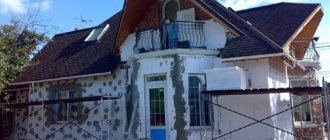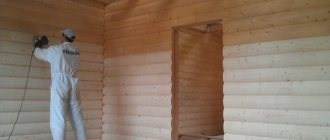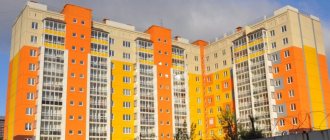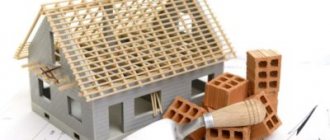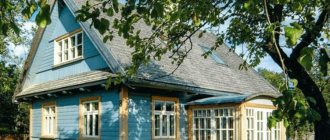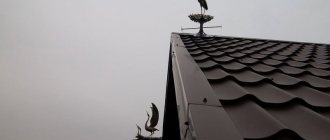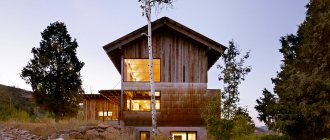Facade facing materials include various types of plaster, facade paints, panels, decorative tiles, stone, etc.
Facade slabs are used for cladding facades in order to protect walls from external influences and provide decorative design; if necessary, they resort to laying insulation between the wall and facade elements.
The range of facade curtain structures is large, so in order to make a choice, you should have information about the materials presented.
Why choose wall panels for exterior decoration of a house?
The development of the construction industry has given rise to the emergence of new modern materials for external cladding, characterized by excellent physical properties and reasonable prices. This is exactly what wall panels are, reducing the cost of building houses, extending its service life, and, at the same time, acting as a protective barrier from rain, snow, ultraviolet radiation, which negatively affects the surface of walls made from almost any building material.
Facade panels for exterior finishing of houses are widely used for treating the external surface of public buildings, private houses and cottages, shopping complexes, entertainment and sports centers, medical and educational institutions.
Wall panels have the following advantages:
- strength;
- frost resistance;
- soundproofing;
- long service life;
- a light weight;
- environmental friendliness;
- affordable price;
- variety of types, textures and colors.
- do not fade in the sun and do not lose color from rain;
- do not require special care or treatment;
- do not rot, are not attractive to insects and rodents;
House finished with facade slabs Source domcom.ru
Cladding panels for the facade of a house are suitable not only for new buildings, but also for finishing old buildings, regardless of the material of the building.
See also: Catalog of companies that specialize in facade and finishing materials.
Decorative slabs for exterior wall decoration are divided into several types, according to material and design:
- Sandwich panels. They consist of several layers of materials glued together. Each layer has different characteristics. The top one is a galvanized metal coating and has a protective function, and the bottom one acts as insulation.
- Composite panels. They are made on a cement base with a fiber filler or a thin layer of metal. This material protects walls well from external environmental influences that contribute to their destruction.
- Plates made of polyvinyl chloride and pressed wood pulp, externally made to look like wood, stone or brick.
Decorative panels for the external walls of a house, belonging to any of these categories, do not put pressure on the load-bearing walls of the building and the foundation.
Installing the entire house with facade slabs does not take much time. The work is completed within a period of two days to two weeks, depending on the area of the facade.
Decorating the wall of a house with facade slabs Source recon-stroi.ru
Kinds
Plastic panels are divided into the following types:
- Under a stone . This type of plastic panels is represented by a variety of product options that can imitate various types of natural stone. The material can look like marble, brickwork, stonework and many other variations . The main advantage of using plastic panels for this type of cladding is that the cost of construction work will be several times less than if natural materials are used.
- Tree . This type of plastic panels is designed to imitate a variety of wood species . The assortment includes species from the simplest and most common tree species to rare and exclusive ones. The panels can also imitate different wood textures.
- Metal . In appearance, products of this type resemble galvanized steel or aluminum ; as for the surface, this material is available with both a smooth and perforated structure of the top layer.
Façade panel options
Panels for the facade of a house are classified according to several characteristics:
- in shape - rectangular, narrow elongated panels or a medium-sized module;
- according to texture - like stone, brick, wood, for painting;
- by the presence of thermal insulation - with or without insulation;
- according to the method of fastening - panels with a locking mechanism or those that do not require fixation with each other;
- by material - composite, polymers, metal, glass.
Metal
They can be made of aluminum or galvanized stainless steel with a polymer coating. They are not subject to corrosion, are not afraid of moisture, do not burn, and are easy to install. The main disadvantage is the lack of thermal insulation capabilities, as well as susceptibility to deformation.
Metal siding to look like wood Source 2gis.ru
Polymer
Polymer or PVC panels are the cheapest and most popular option for facade finishing. They have a wide range of colors and are also available in versions that imitate natural materials. Plastic panels for home decoration are very light and easy to install, in addition, they have a long shelf life.
Main manufacturers
A huge number of foreign and domestic manufacturers offer vinyl panels for facades that will help add aesthetics and protect the structure. The most popular brands are:
- Alta-Profile. It has a wide range of products, which includes elements that can be used to cladding walls and plinths, finishing slopes, corners and other additional parts.
- Dock. One of the leaders in finishing materials. With these PVC panels you can create a reliable and beautiful façade that is resistant to the development of pathogens, low temperatures and other aggressive factors.
- FineBer. Innovative technologies make it possible to create a finish that perfectly replicates the texture of natural materials at minimal cost.
- Nailite. They have a long service life due to their high strength and reliability. The products comply with European standards.
There are also lesser-known manufacturers of plastic products. Before purchasing a finishing material, you should carefully study the characteristics, as well as reviews of use.
Video description
In our video we will talk about Japanese facades. Let's take a closer look at what errors happen during the installation process:
Brick panels
Brick decoration of the external walls of a house has remained popular for many years; it gives the house an expensive look and a special zest. But at the same time, it requires certain costs; in addition to purchasing the material itself, it is necessary to purchase a solution and pay for the work of the master. But in the modern building materials market, an excellent, cheaper alternative to brick finishing has appeared - brick-look wall panels.
The characteristics of such panels are not inferior to natural brick, and in appearance they are almost no different from it. The structure can be homogeneous or combined (equipped with insulation).
Pros and cons of facing slabs
The advantages and disadvantages of different types of facade panels are presented in the table:
| Type of panels | pros | Minuses |
| Metal | low weight; affordable price; fire resistance; durability and strength. | the need to hire workers for installation; poor thermal insulation. |
| PVC | moisture resistance; frost resistance; ease of installation; resistance to environmental influences; environmental friendliness; low cost; wide range of colors; durability. | flammability; toxicity when burning; fragility. |
| Fiber cement | long service life; heat resistance; not subject to rotting and corrosion; | high moisture absorption (absorb up to 10% moisture from the air); subject to deformation; low impact resistance. |
| Clinker | moisture resistance; environmental friendliness; strength; low weight; variety of textures and colors. | surface preparation required before installation; high price; Vapor tightness (requires leaving space between the panel and the wall). |
| Sandwich panels | operation over 30 years; fire safety do not rot or rust; environmental friendliness; thermal insulation; strength; moisture resistance | require care during transportation and installation; freeze at temperatures from -200 C. |
| Glass | original design; good heat and sound insulation; absorption of UV rays. | low installation speed; high price. |
What to look for when choosing
The facade must have a long service life, be functional and resistant to many negative factors. That is why you should be responsible when choosing wall panels for the facade of a house.
When choosing a material, you should pay attention to the following aspects:
- There is a need for thermal insulation . If the walls of the building require additional insulation, it is optimal to choose panels with insulation. In this case, two problems will be solved with one material.
- Environmental conditions. For example, in case of high humidity, you should avoid those types that have a high level of moisture absorption, and for regions with a lot of sunny days, you should not choose panels that are likely to fade in the sun.
- Also, you should take into account the thickness of the walls of the building and its age .
Original house decorated with facade slabs Source prorab.guru
Thermal panels for facades
A universal building material suitable for simultaneous insulation and cladding of the external walls of any building or structure.
The tight connection of individual elements with each other guarantees the absence of cold bridges, which can cause destruction of the walls or damage to their integrity.
Insulators ShF-20G- Production of plastic for finishing
How and how to caulk a timber house with your own hands: materials and step-by-step instructions
Installation features
Installation of panels for facade cladding requires preliminary preparation of the walls. The walls need to be cleaned of old finishes, dirt and dust, then treated with a layer of primer and a special compound.
Next, if necessary, the sheathing is installed. The facing frame is assembled from a thin metal profile or wooden slats. The frame needs to be treated with an anti-rust and rotting compound.
The lathing will provide additional thermal insulation; in addition, the walls will be ventilated, which will maintain a comfortable temperature in the room.
Then, the panels are attached to the supporting frame with nails, dowels or screws. In the absence of sheathing, the plates are simply glued to the wall with a special compound.


